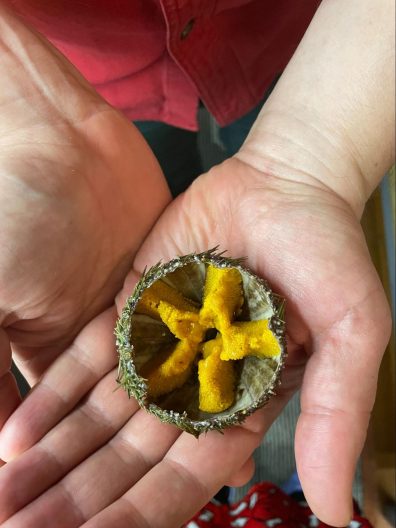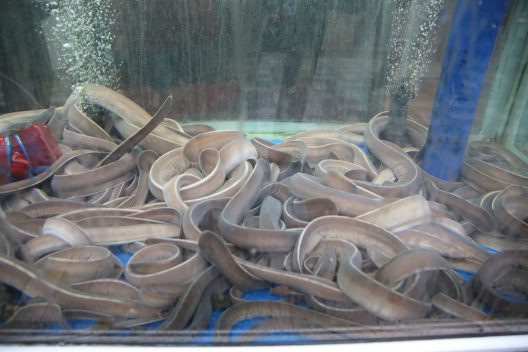Plenty of Fish in the Sea: Three Fisheries You Didn’t Know You Needed to Know About
If you love fisheries as much as I do, perhaps this situation sounds familiar. I am at another social function in the Pacific Northwest. There are snacks, laughter, beverages, and lots of conversation. Like most of the social functions I have been attending recently, this one revolves around fish. Maybe it was that fishery speaker series reception I go to every week? Perhaps that meet-and-greet for the regional fisheries management council? Could be one of those seafood festivals I have been working at a lot lately? No matter where I have gone this past year, my lovely, fishery-obsessed chums, colleagues, and associates only want to talk about salmon. King salmon this, a little coho salmon that. I don’t blame them. If you look around the state, it is hard to sneeze without hitting a salmon-themed sign or statue. Occasionally someone brings up a Dungeness crab or a Pacific halibut to mix it up a bit. While I love all salmon, Dungeness crabs, and of course, halibut, I definitely do not know enough to impress all these fish folks with salmonid small talk. So I go for the edgier stuff—the less known commercial fisheries of Washington, the hip fisheries that no one is talking about just to show that I, too, am a fish nerd. So if you find yourself at one of these fishery events like me and feel similarly inadequate at fish-based small talk, read on and I will tell you about Washington’s hottest new fisheries.
“From the state’s first MSC-certified fishery to one that sells slimy, jawless fish solely to South Korea, there is an interesting variety of cool fisheries in Washington waters.”
Okay, they are not that new, but they may surprise you. From the state’s first fishery to be certified sustainable by the Marine Stewardship Council, to one that sells slimy, jawless fish solely to South Korea, there is an interesting variety of cool fisheries in Washington waters.
Pink Shrimp (Pandalus jordani)
When I think of large, commercial shrimp fisheries in the U.S., my mind goes to the warm waters of the Gulf of Mexico where the famous, fictitious shrimper, Forrest Gump, got his start. But since the late 1950s, Washington has had a large-scale commercial coastal shrimp fishery too. The late ‘50s and early ‘60s trend for cocktail shrimp spurred the fishery to grow rapidly. For us shrimp aficionados, the cocktail shrimp craze has never ended. These days, the shrimp caught in this fishery are usually served as “salad shrimp”, in a “shrimp roll”, or as “peel-and-eat shrimp”.
- Some folks, like Evan, carry the spirit of the cocktail shrimp trend with them wherever they go. Photo courtesy of Kelly Greenwood, shared with permission.
- Bag of frozen, wild caught, West Coast pink shrimp. Photo courtesy of Erick Dowell, shared with permission.
Pink shrimp range from Southeast Alaska down into northern California waters. These arthropods are caught by midwater trawlers along the continental shelf. The boats that come back to Washington have their catch processed in either Ilwaco or Westport. In 2022, the catch was around 24.5 million pounds and valued around $11.6 million. This makes the pink shrimp fishery, on average, the fourth most valuable fishery in Washington. In 2015, this fishery became Washington’s first certified in accordance with the Marine Stewardship Council (MSC) Fisheries Standard. You may have seen the MSC’s blue fish logo on seafood products at stores. This certification, which is re-evaluated annually, is given to fisheries that manage their catch in a sustainable way. The sustainability of this fishery is notable since there is no catch limit for the shrimp. Each year, managers monitor the total catch and shrimp reproduction rates. Researchers have determined that reproduction and population growth mostly rely on how well the shrimp hatching period matches with spring upwelling, and not catch. Fishermen and managers are proud of the MSC certification and have worked proactively to maintain sustainability in the shrimp fishery.
The greatest threat to the pink shrimp fishery’s sustainability is its bycatch: any non-target species caught in a fishery. Bycatch is a large problem in most shrimp fisheries. Pink shrimp are at their largest 15 cm (6 in.) long; the nets used to catch them only have tiny openings which can catch anything shrimp-sized or bigger. Managers avoid some bycatch by requiring Bycatch Reduction Devices (BRDs) in the shrimp nets. These BRDs are grates with ¾” spacings that allow shrimp to pass through into the end of the net, while most fish cannot fit through the grate and are directed towards an opening in the net to escape. The most concerning part of this fishery’s bycatch is a fish called eulachon (Thaleichthys pacificus). The southern population of eulachon in Washington waters is listed as threatened under the Endangered Species Act. So far, bycatch levels have been acceptable, and managers require LED lights on shrimp nets which have been shown to deter eulachon from getting caught in the nets. If eulachon bycatch becomes too high, then managers may shut down shrimping in those areas.These fishery closure measures would be to ensure the sustainability of the fishery and maintain its MSC certification.
Although these shrimps are tiny, you can certainly make a splash by mentioning this fishery at your next fishery science function, and folks will love it when you bring along a shrimp cocktail to share.
Sea Urchins
Green urchin (Strongylocentrotus droebachiensis)
Red urchin (Mesocentrotus franciscanus)

Yes, you read that right! The porcupines of the sea, urchins are widespread around the globe. Maybe you have had the misfortune of touching one of Neptune’s spiky tennis balls. I have, and it hurts. Believe it or not, people fish for these and eat them! Now, don’t go trying to take a big bite out of one of these spiny, underwater baseballs—the edible part is inside all of those spines. If you have been to a sushi restaurant, you may have seen uni on the menu. If you crack open an urchin, the orange, tongue-shaped stripes are the edible uni, the sea urchins’ eggs. Uni is akin to fish roe (eggs), but creamier and not as salty. Most folks around the world eat sea urchin uni fresh and raw, straight from the sea. You can also eat it cooked. I personally like cooking uni with scrambled eggs, soy sauce, and scallions, or making a pasta dish with spaghetti and sour cream.
Sea urchins continue to be an important traditional food for Tribes and First Nations in the Pacific Northwest. In Washington state, Tribes co-manage the sea urchin harvest and rules with state fishery managers to promote the sustainability of the fishery. Fishery rules include size limits, closed fishing areas, seasons, and allowable fishing gear.
“Sea urchins continue to be an important traditional food for Tribes and First Nations in the Pacific Northwest. In Washington state, Tribes co-manage the sea urchin harvest and rules with state fishery managers to promote sustainability of the fishery.”
Sea urchins have been fished globally for millennia, and the methods have changed little. You just pick them up with your (gloved!) hands. While you can reach some from shore at low tides, fishers have had the most success diving for them. Some fishers still do the classic free-dive to collect urchins, but most modern harvesters dive with air hoses connected to their boats.
Most of these urchins are shipped fresh to east Asia, but you can sometimes find them in local seafood markets in western Washington. If you are an adventurous type, you can fish for urchins recreationally as long as you have a Washington state shellfish fishing license, snorkel gear, and gloves. You will definitely impress if you bring some self-caught uni to your next fishery-focused potluck.
Hagfish
Pacific hagfish (Eptatretus stoutii)
Black hagfish (Eptatretus deani)
What are things that you look for in a favorite fish? Do you like loose-fitting skin? Great! No jaw? Perfect! A terrifying mouth? Absolutely! Ability to secrete massive amounts of suffocating slime as a defense mechanism?! SAY NO MORE! Well, have I got the fish for you: meet the hagfish! They are a jawless fish that lives in deep coastal waters and mainly feeds on dead sea creatures that have sunk to the bottom. Okay, maybe you are not as stoked as I am about these remarkable fish, but would you believe that there is a fishery in Washington for two species of hagfish? You almost certainly have not seen hagfish in a grocery or offered on a menu in the U.S. Almost all of the hagfish caught in the U.S. are exported to South Korea where they are a local delicacy.

In South Korea, hagfish can be eaten raw, grilled, or marinated and cooked. Even their cool snotty force fields are sometimes used as an egg white substitute! They can be eaten with onion and garlic, or sometimes diced and cooked with a red pepper sauce—yum.
Even though these “snot snakes” (yes, that’s a real nickname) are jawless fish that swim, they are caught similarly to lobster. A series of traps called pots are baited and dropped to the bottom. These pots are usually tubular and have skinny entrances that let the hagfish in, but make it very hard for them to get out. Old pickle or olive barrels are sometimes used as the traps! There are few restrictions and regulations on the hagfish fishery, other than you can only fish for them at 50 fathoms (300 ft) depth or deeper. Once they are caught, they are usually shipped to overseas markets fresh or frozen. This fishery is still a trial fishery and was established under the Emerging Commercial Fishery Act to evaluate whether it would be profitable and sustainable.
If you really want to spice up your next fishery conversation, do be sure to mention these little “slime eels” (another real nickname).
So, there you go! No need to feel like you do not have a conversational edge on all those salmon or crab experts out there next time you find yourself chatting about fishing regulations, foreign fish markets, or even swapping recipes. Shoot your shot and show that you know about the coolest local fisheries, the less well-known ones, the hip ones. It will really impress those folks or at least show that you are a fishery aficionado with discerning tastes. Good luck out there!

